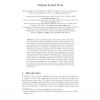Free Online Productivity Tools
i2Speak
i2Symbol
i2OCR
iTex2Img
iWeb2Print
iWeb2Shot
i2Type
iPdf2Split
iPdf2Merge
i2Bopomofo
i2Arabic
i2Style
i2Image
i2PDF
iLatex2Rtf
Sci2ools
WADS
2009
Springer
2009
Springer
Minimal Locked Trees
Locked tree linkages have been known to exist in the plane since 1998, but it is still open whether they have a polynomial-time characterization. This paper examines the properties needed for planar trees to lock, with a focus on finding the smallest locked trees according to different measures of complexity, and suggests some new avenues of research for the problem of algorithmic characterization. First we present a locked linear tree with only eight edges. In contrast, the smallest previous locked tree has 15 edges. We further show minimality by proving that every locked linear tree has at least eight edges. We also show that a six-edge tree can interlock with a four-edge chain, which is the first locking result for individually unlocked trees. Next we present several new examples of locked trees with varying minimality results. Finally, we provide counterexamples to two conjectures of [12], [13] by showing the existence of two new types of locked tree: a locked orthogonal tree (a...
| Added | 25 May 2010 |
| Updated | 25 May 2010 |
| Type | Conference |
| Year | 2009 |
| Where | WADS |
| Authors | Brad Ballinger, David Charlton, Erik D. Demaine, Martin L. Demaine, John Iacono, Ching-Hao Liu, Sheung-Hung Poon |
Comments (0)

